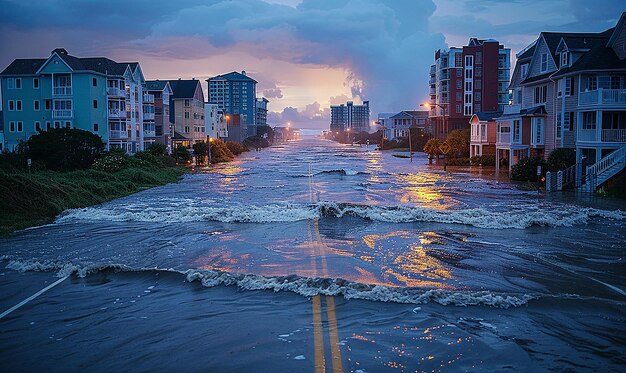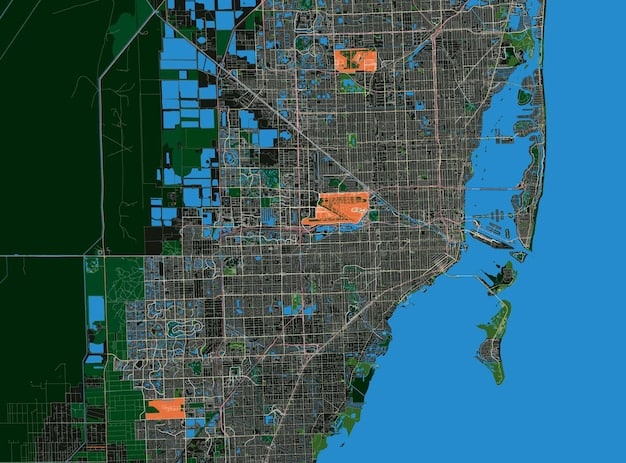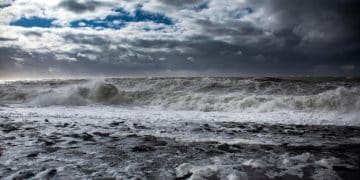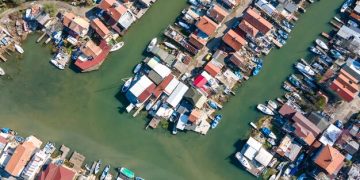US Coastal Communities: 1.5°C Rise Impact by 2025

The projected 1.5°C global temperature rise is poised to significantly impact US coastal communities by 2025, leading to accelerated sea-level rise, increased frequency of extreme weather events, and amplified socioeconomic challenges for vulnerable populations and infrastructure.
The urgency surrounding climate change has never been more palpable, as scientific projections continue to paint a stark picture of our immediate future. A critical question on many minds, particularly for those residing along the nation’s extensive shorelines, is: How will the projected 1.5 degree Celsius temperature rise impact US coastal communities by 2025? This isn’t merely an academic exercise; it’s a pressing concern that demands a nuanced understanding of environmental shifts and their multifaceted repercussions on human settlements and natural ecosystems.
Understanding the 1.5°C Threshold and Its Proximity
The 1.5°C threshold has emerged as a critical benchmark in climate science, representing a point beyond which the risks of severe climate impacts significantly increase. While 2025 is an incredibly close timeframe, the warming isn’t expected to happen uniformly overnight; rather, the “projected 1.5°C rise” refers to the global average temperature increase since pre-industrial times, which could be reached or even temporarily exceeded within the coming years. This seemingly small increment masks profound implications for global systems, especially our oceans and coastal zones. The scientific consensus, often articulated by bodies like the Intergovernmental Panel on Climate Change (IPCC), indicates that we are rapidly approaching this mark.
The significance of this benchmark lies in the potential for triggering various tipping points within Earth’s climate system. Exceeding 1.5°C, even temporarily, can accelerate processes that are already underway. For coastal communities, this means an intensification of challenges they are already grappling with, such as rising sea levels, increased storm intensity, and coastal erosion. The timeframe to 2025 is remarkably short, emphasizing that adaptation and mitigation efforts must be implemented with unprecedented speed and scale to avert the most severe consequences. Understanding the immediacy of this threat is crucial for policymakers and residents alike.
The Science Behind the 1.5°C Projection
Scientists rely on complex climate models and extensive data sets to project future temperature scenarios. These models incorporate various factors, including greenhouse gas emissions, ocean heat uptake, and aerosol effects. The 1.5°C target stems from the Paris Agreement, where nations committed to “holding the increase in the global average temperature to well below 2°C above pre-industrial levels and pursuing efforts to limit the temperature increase to 1.5°C.” Recent reports indicate that the 1.5°C threshold could be reached or even temporarily breached within the next five years, making the 2025 timeframe highly relevant.
These projections are not arbitrary but are based on a rigorous understanding of Earth’s energy balance and the unprecedented rate at which human activities are altering it. The models provide a range of possibilities, but the trend is clear: warming is occurring, and its pace is accelerating. This scientific foundation underpins the urgency of addressing climate change impacts in coastal areas.
* Data Assimilation: Global climate models incorporate vast amounts of observational data, from satellite imagery to oceanographic measurements.
* Emission Scenarios: Projections consider various pathways for future greenhouse gas emissions, influencing the timing of warming thresholds.
* Feedback Loops: The models account for complex natural processes, such as melting ice reflecting less sunlight, which can amplify warming.
Historical Context of Warming
To fully grasp the implications of a 1.5°C rise by 2025, it’s essential to consider the historical context. The Earth has already warmed by approximately 1.1°C to 1.2°C since the pre-industrial era, with the most significant warming occurring in recent decades. The rapid progression from current temperatures to the 1.5°C mark highlights the accelerating pace of climate change. This historical trend suggests that impacts once considered distant are now on our immediate horizon.
The current rate of warming means that changes that took centuries to manifest in previous geological periods are now happening within decades. This compressed timeline leaves less room for natural systems and human societies to adapt gradually, amplifying the disruptive potential of even small increases in global average temperature. The pre-industrial baseline serves as a reference point to quantify the scale of human-induced warming.
The projected 1.5°C rise is not merely an incremental change from current conditions; it signifies a further acceleration of trends already observed, increasing the frequency and intensity of climate-related disruptions. Understanding this progression is fundamental to appreciating the scale of the challenge confronting US coastal communities.
Accelerated Sea-Level Rise and Coastal Flooding
One of the most immediate and profound impacts of a 1.5°C temperature rise on US coastal communities by 2025 will be the acceleration of sea-level rise and the concomitant increase in coastal flooding. Even a slight increase in global temperatures amplifies two primary drivers of sea-level rise: thermal expansion of ocean water and the melting of glaciers and ice sheets. By 2025, these processes will contribute to more frequent and prolonged “sunny day” flooding, where high tides alone inundate low-lying areas, independent of storm events.
This phenomenon is already a reality in many coastal cities, from Miami to Annapolis, and its frequency is only expected to intensify. Critical infrastructure, including roads, wastewater treatment plants, and ports, will face increasing disruption, leading to economic losses and public health concerns. The projected warming will exacerbate existing vulnerabilities, making once-rare flood events commonplace and pushing communities closer to permanent inundation.
Thermal Expansion and Ice Melt Dynamics
The physics behind sea-level rise are straightforward: as the ocean warms, its volume expands. Concurrently, warmer temperatures accelerate the melting of land-based ice, including glaciers and the massive ice sheets in Greenland and Antarctica, adding vast quantities of water to the oceans. While the full, long-term impact of ice sheet collapse will unfold over centuries, the initial melting contributes measurably to short-term sea-level rise.
The rate of thermal expansion is directly proportional to ocean temperature, meaning that as global averages climb toward 1.5°C, so too will this contributor to sea-level rise. The combined effect of these two processes predicts an undeniable and rapid increase in ocean levels along the US coastlines.
* Ocean Heat Capacity: Oceans absorb over 90% of the excess heat trapped by greenhouse gases, leading to expansion.
* Glacial Retreat: Mountain glaciers globally are shrinking at unprecedented rates, contributing directly to sea-level rise.
* Polar Ice Melt: Greenland and Antarctic ice sheets are losing mass at an accelerating pace, with significant long-term implications.
Increased Frequency of High-Tide Flooding
Coastal communities in the US are already experiencing a noticeable increase in “nuisance” or “sunny day” flooding, which occurs during exceptionally high tides even without heavy rainfall or storm surges. By 2025, with a 1.5°C rise, the baseline sea level will be higher, meaning that high tides that once caused minor ponding will now lead to significant inundation of streets, homes, and critical infrastructure.
This type of flooding disrupts daily life, makes roads impassable, contaminates freshwater sources, and forces businesses to close. For communities with significant tidal ranges, the frequency of these events can multiply exponentially with even a small increase in average sea level, creating a chronic challenge for urban planners and emergency services.
The economic burden of such frequent flooding can be substantial, affecting property values, increasing insurance costs, and diminishing local economies reliant on coastal access, such as tourism and fishing. The cumulative impact of these chronic events can be as damaging as, if not more so, than, episodic large storms. Even without dramatic storm events, the simple rise in sea level causes insidious, pervasive impacts.
Intensified Extreme Weather Events and Storm Surges
As global temperatures approach the 1.5°C mark by 2025, US coastal communities will likely face an intensification of extreme weather events, particularly tropical cyclones and their associated storm surges. While the total number of storms may not necessarily increase dramatically, climate change is expected to lead to a higher proportion of stronger, more destructive storms. Warmer ocean waters provide more energy for hurricanes, leading to more rapid intensification and higher sustained wind speeds.
Crucially, rising sea levels mean that storm surges, which are already devastating, will ride on a higher baseline. This effectively amplifies the reach and destructive power of a given storm, pushing floodwaters further inland and into areas previously considered safe. For coastal communities, this translates to increased risks of property damage, infrastructure failure, and loss of life, necessitating more robust preparedness and response strategies.
Hurricane Intensity and Precipitation
Warmer sea surface temperatures fuel more intense hurricanes, increasing the likelihood of Category 3, 4, and 5 storms making landfall. These powerful storms not only bring destructive winds but also unleash torrential rainfall. A warmer atmosphere holds more moisture, meaning that when these systems encounter land, they can dump unprecedented amounts of rain, leading to widespread freshwater flooding in addition to coastal inundation.
The combination of heightened wind damage and extreme precipitation presents a dual threat to coastal regions. Infrastructure is designed to withstand certain thresholds, and when these are exceeded, the cascading failures can be catastrophic, paralyzing transportation, power, and communication networks for extended periods.
* Increased Storm Category: Higher sea surface temperatures provide the energy needed for storms to reach higher intensity levels.
* Larger Rainfall Totals: A warmer atmosphere retains more moisture, leading to exceptionally heavy rainfall during tropical storms.
* Slower Storm Movement: There’s evidence that some storms are moving more slowly, prolonging exposure to damaging winds and rain.
Coastal Erosion and Infrastructure Vulnerability
The relentless assault of more frequent and intense storms, coupled with accelerating sea-level rise, will significantly exacerbate coastal erosion. Beaches, dunes, and barrier islands, which act as natural protective barriers, will be increasingly vulnerable. This erosion not only reduces natural habitats but also directly threatens coastal properties and infrastructure established too close to the retreating shoreline.
Roads, bridges, water treatment facilities, and power grids located in low-lying coastal areas are at extreme risk. Repairing or relocating this infrastructure is astronomically expensive and often disruptive. The cumulative damage from multiple smaller events, interspersed with occasional major storms, creates a perpetual state of vulnerability and costly recovery.

The economic and social implications of infrastructure failure are profound, affecting supply chains, emergency response, and overall community resilience. As the 2025 deadline approaches, coastal communities must reassess their existing infrastructure for climate resilience.
Ecosystem Disruption and Economic Impacts
Beyond the immediate physical destruction, the projected 1.5°C temperature rise will have significant ecosystem disruption and subsequent economic impacts on US coastal communities by 2025. Coastal ecosystems, such as salt marshes, mangroves, oyster reefs, and barrier islands, provide critical services including storm protection, water filtration, and habitat for commercially important species. These ecosystems are highly sensitive to changes in temperature, salinity, and water levels.
As sea levels rise and temperatures increase, these crucial habitats will face increased stress, leading to species migration, reduced biodiversity, and outright loss. The economic ramifications are direct: declines in fisheries, impacts on tourism reliant on healthy beaches and marine life, and increased costs for coastal protection now that natural barriers are diminished. The feedback loop is clear: environmental degradation translates directly into economic hardship.
Impact on Fisheries and Aquaculture
Changes in ocean temperature, salinity, and oxygen levels can greatly affect marine species. Many fish and shellfish populations are sensitive to these environmental shifts, leading to changes in migration patterns, breeding success, and overall stock abundance. For coastal communities heavily reliant on fishing and aquaculture, a 1.5°C rise by 2025 could mean significant disruptions.
Reduced fish stocks translate directly into lost livelihoods, decreased revenue for fishing industries, and higher seafood prices for consumers. Aquaculture operations, often located in sensitive coastal areas, are also vulnerable to rising water temperatures, increased storm surges, and ocean acidification (an indirect consequence of CO2 absorbed by oceans, exacerbated by warming).
* Species Migration: Many marine species will shift their ranges to cooler waters, impacting traditional fishing grounds.
* Breeding Disruption: Changes in temperature can interfere with the reproductive cycles of fish and shellfish.
* Disease Outbreaks: Warmer waters can increase the prevalence of certain marine diseases, affecting farmed and wild stock.
Tourism and Recreation Declines
Coastal tourism is a cornerstone of many US coastal economies. Beaches, pristine waters, and healthy ecosystems attract millions of visitors annually. However, increased coastal erosion, more frequent beach closures due to flooding or contamination, and the degradation of natural attractions like coral reefs will severely impact this sector.
When beaches disappear or are frequently inundated, their appeal diminishes. Damage to recreational infrastructure, such as marinas and boardwalks, during storms also deters visitors. These declines in tourism revenue affect local businesses, employment rates, and the overall economic vitality of coastal towns. The pristine image many tourists seek will be increasingly difficult to maintain.
The long-term viability of coastal tourism hinges on the health of the coastal environment. Addressing the impacts of a 1.5°C rise is not just an environmental imperative but an economic necessity for these communities.
Human Migration and Socioeconomic Challenges
The combination of accelerated sea-level rise, intensified extreme weather, and ecosystem disruption will inevitably lead to significant human migration and exacerbate socioeconomic challenges within US coastal communities by 2025. As homes become uninsurable, infrastructure crumbles, and livelihoods disappear, internal climate migration will likely accelerate. This displacement will disproportionately affect low-income communities and communities of color, who often have fewer resources to adapt or relocate.
Furthermore, the financial burden of climate impacts will strain local economies and government resources. Increased costs for disaster response, infrastructure repair, and potentially managed retreat will divert funds from other essential services, widening existing inequalities and potentially fueling social unrest. The cascading effects on physical and mental health cannot be overstated, as chronic stress, displacement, and loss take their toll.
Displacement and Relocation Pressures
As coastal areas become progressively less habitable due to chronic flooding and storm damage, more residents will face immense pressure to relocate. This process, often termed “climate migration,” is complex and fraught with challenges. It involves not just moving people but also dismantling established communities, severing social ties, and seeking new economic opportunities elsewhere.
This displacement is rarely equitable; wealthier individuals often have more options for relocation, while vulnerable populations may be trapped in increasingly precarious situations or forced into congested, less-resourced urban centers. Without proactive planning, climate migration can lead to exacerbated housing shortages, increased social service demands, and potential conflicts in recipient communities.
* Forced Displacement: Residents are compelled to leave homes due to repeated damage or permanent inundation.
* Economic Stress: Loss of property value, uninsurability, and lack of livelihood can force relocation.
* Social Disruption: Breaking established community bonds and support networks leads to psychological stress.
Economic Burden on Local Governance
Coastal municipalities are on the front lines of climate change, bearing the brunt of rising costs associated with adaptation and disaster recovery. Even by 2025, with a 1.5°C rise, the financial demands will become overwhelming for many. Budget lines for infrastructure maintenance, emergency services, and coastal protection will swell, often without commensurate increases in revenue.
Property tax bases may shrink as properties become less valuable or uninsurable, further eroding local government capacity. The need for massive investments in seawalls, elevated infrastructure, or even managed retreat strategies will dwarf the financial capabilities of most local and state governments, forcing difficult choices and potentially leading to a decline in other essential public services.

This looming financial crisis highlights the need for significant federal and state support, as individual communities cannot shoulder this burden alone. The projected 1.5°C rise will accelerate this fiscal challenge immediately.
Adaptation Measures and Policy Implications
Addressing the projected 1.5°C temperature rise and its impacts on US coastal communities by 2025 necessitates urgent and comprehensive adaptation measures, supported by robust policy frameworks. While some impacts are now unavoidable, strategic interventions can significantly mitigate the worst outcomes. These measures range from enhancing natural coastal defenses to implementing strict building codes and reimagining urban planning in flood-prone areas.
Effective policy must bridge the gap between scientific projections and practical implementation, involving all levels of government, private sector stakeholders, and local communities. The short timeframe to 2025 provides a narrow window for accelerating existing initiatives and developing innovative solutions that prioritize resilience and equity. The shift from reactive disaster response to proactive, long-term planning is paramount.
Natural and Engineered Defenses
A dual approach combining natural and engineered defenses is crucial for protecting coastal communities. Natural solutions include restoring and preserving wetlands, mangroves, oyster reefs, and sand dunes, which act as living barriers to storm surges and erosion. These “green infrastructure” solutions offer co-benefits like habitat creation and carbon sequestration.
Engineered solutions, such as seawalls, levees, and elevated structures, provide hard protection for critical infrastructure and high-value assets. However, these are often expensive, can disrupt natural processes, and may only provide temporary solutions against accelerating sea-level rise. A balanced strategy that leverages the strengths of both approaches will be most effective by 2025.
* Green Infrastructure: Promoting natural solutions like wetland restoration for ecological and protective benefits.
* Hardening Measures: Constructing seawalls and dikes to protect vulnerable coastal assets.
* Building Codes: Implementing stricter building codes requiring elevation and flood-resistant materials.
Managed Retreat and Strategic Relocation
For some highly vulnerable areas, particularly those facing chronic inundation or extreme storm risk, managed retreat may become an increasingly necessary, albeit challenging, adaptation strategy. This involves strategically moving people, infrastructure, and development away from the most at-risk coastal areas. It is a long-term, complex process that requires careful planning, community engagement, and significant financial investment.
By 2025, initial discussions and pilot programs for managed retreat may become more prevalent, though broad implementation will take longer. The concept acknowledges that not all land can or should be protected, and sometimes, moving away from danger is the most fiscally and environmentally responsible course of action. This strategy challenges traditional notions of property rights and requires creative solutions for land use planning and equitable relocation support.
Implementing managed retreat also involves overcoming significant social and psychological barriers. Communities have deep roots, and the decision to abandon homes and cultural sites is emotionally charged. However, proactive planning can ensure that retreat is managed ethically and equitably, minimizing disruption and maximizing the long-term well-being of affected populations.
Looking Beyond 2025: Long-Term Outlook and Resilience
While the 2025 timeframe for the 1.5°C threshold presents immediate challenges, it is crucial for US coastal communities to also consider the longer-term outlook and build sustained resilience. The impacts observed by 2025 will only intensify in the subsequent decades if greenhouse gas emissions are not drastically reduced. The actions taken in the short term will significantly determine the magnitude of future risks and the capacity of communities to adapt.
Building resilience is not a static goal but an ongoing process that requires continuous monitoring, reassessment, and adaptation to evolving climate conditions. It involves fostering robust governance, diverse economies, strong social networks, and a deep understanding of environmental systems. Planning beyond 2025 means preparing for future projections, including potentially higher temperature thresholds and more severe impacts, while simultaneously working towards global emission reductions.
Investing in Climate-Resilient Infrastructure
Beyond 2025, continued and expanded investment in climate-resilient infrastructure will be vital. This includes not only repairing and elevating existing structures but also designing new infrastructure that can withstand future climate extremes. Moving critical facilities out of floodplains, developing smart energy grids capable of decentralization, and improving public transportation resilience are examples of necessary long-term investments.
Financing these large-scale projects will require innovative public-private partnerships, federal funding, and potentially new taxation mechanisms. The cost of inaction—measured in repeated disaster recovery, economic stagnation, and human suffering—will far outweigh the upfront investment in resilience. Long-term planning allows for more systematic, cost-effective solutions rather than reactive, piecemeal repairs.
* Elevated Structures: Building homes and critical facilities on higher ground or on stilts to escape rising waters.
* Green Infrastructure Adoption: Investing in natural systems like living shorelines for multi-benefit protection.
* Smart Grid Development: Creating more decentralized and resilient power systems less susceptible to widespread outages.
Fostering Community Preparedness and Education
Ultimately, the resilience of coastal communities depends on the informed engagement of their residents. Beyond 2025, continuous investment in community preparedness and education will be paramount. This involves clear communication from local authorities about risks, evacuation routes, and emergency procedures. It also means empowering residents with knowledge about flood insurance, property elevation, and local adaptation plans.
Education can also foster a sense of shared responsibility and collective action. By understanding the immediate and long-term implications of a 1.5°C rise, communities can advocate for more effective policies, participate in planning processes, and take individual actions to reduce their vulnerability. A well-informed and engaged citizenry is the strongest defense against the mounting challenges of climate change.
The path to resilience is not without its difficulties, but through strategic planning, investment, and community collaboration, US coastal communities can better navigate the landscape shaped by a warming planet. The immediate impacts by 2025 serve as a stark warning, highlighting the urgency of both adaptation and global climate action.
| Key Impact Area | Brief Description by 2025 |
|---|---|
| 🌊 Sea-Level Rise | Increased frequency of “sunny day” flooding and chronic inundation for low-lying coastal areas. |
| ⛈️ Extreme Weather | More intense hurricanes and storm surges causing greater inland flooding and infrastructure damage. |
| 🐠 Ecosystem Stress | Degradation of vital coastal habitats, impacting fisheries and natural storm protection. |
| 🧑🤝🧑 Socioeconomic Shifts | Increased pressure for managed retreat, higher costs for adaptation, and potential displacement of vulnerable populations. |
Frequently Asked Questions About 1.5°C Rise and Coastal Impacts
While models project that the global temperature could reach or temporarily exceed 1.5°C between now and 2025, it’s not a guaranteed permanent state. Various climate models indicate a significant probability, making it a critical benchmark for near-term planning and impact assessment, particularly for sensitive coastal regions. The speed of emissions reductions remains a key factor.
A 1.5°C rise by 2025 is expected to accelerate sea-level rise and extreme weather events, leading to increased coastal flooding and erosion. This will likely depress property values in vulnerable areas, increase insurance premiums, and potentially make some properties uninsurable or unsuitable for continued habitation, exacerbating existing financial strains on homeowners and communities.
By 2025, infrastructure most at risk includes roads, bridges, wastewater treatment plants, power substations, ports, and airports located in low-lying coastal areas. Increased tidal flooding and storm surges directly threaten these vital systems. The impacts can lead to severe disruptions in transportation, sanitation, energy supply, and overall economic activity, requiring costly repairs or relocation.
While full adaptation to all future changes by 2025 is unrealistic given the scale of the challenge, communities can implement significant short-term measures. These include enhancing natural defenses, elevating critical infrastructure, updating building codes, and improving early warning systems. Proactive planning and investment now can substantially mitigate immediate risks and build a foundation for long-term resilience.
Individuals can contribute by supporting local adaptation plans, advocating for climate-resilient policies, and taking personal preparedness steps like having flood insurance or elevating homes where possible. Reducing one’s carbon footprint annually also contributes to the broader global effort to limit warming, which is crucial for long-term coastal stability and community well-being.
Conclusion: A Call for Urgent, Collaborative Action
The projected 1.5°C temperature rise by 2025 is not a distant threat but an imminent reality for US coastal communities. From accelerated sea-level rise and intensified extreme weather events to pervasive ecosystem disruption and profound socioeconomic challenges, the impacts demand immediate and decisive action. While the natural world will respond according to its immutable laws, human decisions and preparations in the next few years will significantly shape the fate of millions living along our fragile coastlines. The path forward requires a blend of robust scientific understanding, innovative adaptation strategies, significant financial investment, and, critically, a unified commitment across all levels of government and within every coastal community to foster resilience and embark on a sustainable future.





